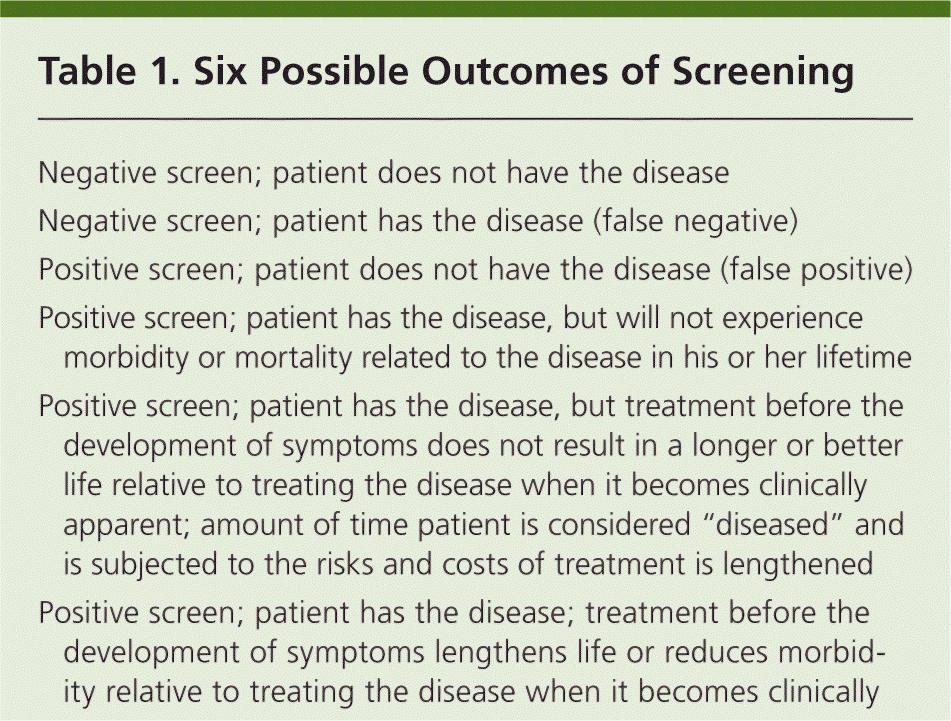
Am Fam Physician. 2010;82(5):468
This is one in a series of pro/con editorials discussing controversial issues in family medicine.
For many conditions, patients who manifest clinical symptoms are just the tip of the iceberg. What happens when we look beneath the surface for asymptomatic disease and its precursors? There are six possible outcomes of screening (Table 1). For five of the six outcomes, the person being screened does not experience any health benefits from the screening.

| Negative screen; patient does not have the disease |
| Negative screen; patient has the disease (false negative) |
| Positive screen; patient does not have the disease (false positive) |
| Positive screen; patient has the disease, but will not experience morbidity or mortality related to the disease in his or her lifetime |
| Positive screen; patient has the disease, but treatment before the development of symptoms does not result in a longer or better life relative to treating the disease when it becomes clinically apparent; amount of time patient is considered “diseased” and is subjected to the risks and costs of treatment is lengthened |
| Positive screen; patient has the disease; treatment before the development of symptoms lengthens life or reduces morbidity relative to treating the disease when it becomes clinically apparent |
Even for the best-established, evidence-based preventive services, at the individual level most persons will not experience health benefits, but will be subjected to the harms and costs associated with the screening and treatment. For example, although all persons who have a colonoscopy and have adenomatous polyps removed experience the cost and discomfort of the procedure, most are not destined to experience morbidity or mortality from colon cancer. When we recommend screening, we ask healthy persons to bear the cost, discomfort, or inconvenience, and risk potential harm.
Then we leverage that against a long-term possibility of reduced morbidity or mortality from the condition we seek to prevent. If we are to ask persons to take this risk, then we should have good evidence that, in the population to whom the preventive service is applied, the net benefit exceeds the harm. The longer it is from the time of screening to the onset of the morbidity or mortality we hope to prevent, the greater the probability that one of the first five outcomes of screening will occur. In the extreme, we may ask children to undergo screening with the hope of avoiding morbidity or mortality that may or may not occur decades later. Screening children two to 10 years of age for lipid disorders is a good example of a preventive service with a 40-year time frame for a hoped for, but unsubstantiated, benefit.1
Only 40 to 55 percent of children with elevated cholesterol and low-density lipoprotein levels will continue to have elevated lipids on follow-up. A recent evidence review supporting the U.S. Preventive Services Task Force statement on lipid screening in children reached the following conclusions: (1) drug treatment for dyslipidemia in children has been studied and shown to be effective only in short-term studies of suspected or proven familial monogenic dyslipidemias; (2) intensive dietary counseling and follow-up can result in improvements in lipids, but these results have not been sustained after the cessation of the intervention; and (3) the few trials of exercise are of fair to poor quality and show little or no improvements in lipids for children without monogenic dyslipid-emias.2 And what harm might we do to inactive children with a poor diet who happen to have a low cholesterol level and are reassured that their lipid values are “normal”? We must be careful that we do not cause unintended negative consequences in our zeal to prevent far-off disease.
It is likely that many causes of morbidity and mortality in adults have precursors in childhood. What evidence should we require to justify looking beneath the surface? The costs and opportunity for harm are enormous; the evidence bar should be high. If we are to be fair to children, we must attempt to protect them from medical care with the same passion as we attempt to protect them with medical care.
